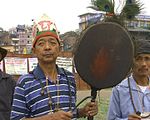Related Research Articles

The harp is a stringed musical instrument that has a number of individual strings running at an angle to its soundboard; the strings are plucked with the fingers. Harps can be made and played in various ways, including standing or sitting and in orchestras or concerts. Its most common form is triangular in shape and made of wood. Some have multiple rows of strings and pedal attachments.

String instruments, stringed instruments, or chordophones are musical instruments that produce sound from vibrating strings when a performer plays or sounds the strings in some manner.

In the study of musical instruments, organology, there are many different methods of classifying musical instruments. Most methods are specific to a particular cultural group and were developed to serve the requirements of that culture and its musical needs. Such classification schemes often break down when applied outside of their original context. For example, a classification based on instrument use may fail when applied to culture which has a different use, or even multiple uses, for the same instrument.
Hornbostel–Sachs or Sachs–Hornbostel is a system of musical instrument classification devised by Erich Moritz von Hornbostel and Curt Sachs, and first published in the Zeitschrift für Ethnologie in 1914. An English translation was published in the Galpin Society Journal in 1961. It is the most widely used system for classifying musical instruments by ethnomusicologists and organologists. The system was updated in 2011 as part of the work of the Musical Instrument Museums Online (MIMO) Project.
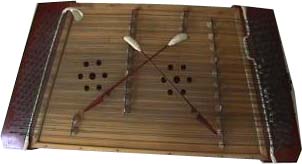
The tsymbaly is the Ukrainian version of the hammer dulcimer. It is a chordophone made up of a trapezoidal box with metal strings strung across it. The tsymbaly is played by striking two beaters against the strings.

The bandurria is a plucked chordophone from Spain, similar to the mandolin, primarily used in Spanish folk music, but also found in former Spanish colonies.
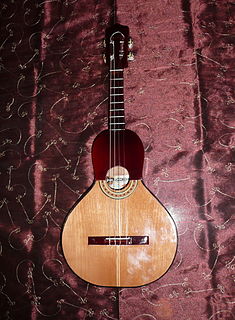
The bandola is one of many varieties of small pear-shape chordophones found in Venezuela and Colombia. They are related to the bandurria and mandolin.

The Celtic harp is a triangular frame harp traditional to Ireland, Wales, and Scotland. It is known as cláirseach in Irish and clàrsach in Scottish Gaelic. In Ireland and Scotland, it was a wire-strung instrument requiring great skill and long practice to play, and was associated with the Gaelic ruling class. It appears on Irish and British coins, the coat of arms of the Republic of Ireland, Montserrat, the United Kingdom and Canada as well as the flag of Montserrat.
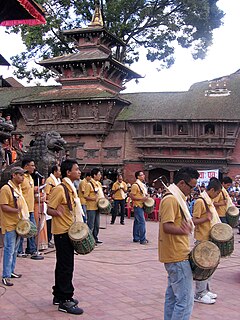
Newa music, also spelled Newar music, is traditional music developed in Nepal by the Newars. The music has its roots in classic Hindu and Buddhist music. It evolved with incorporation of folk music of the Kathmandu valley and its peripheries. Musical instruments mainly consist of percussion and wind instruments.
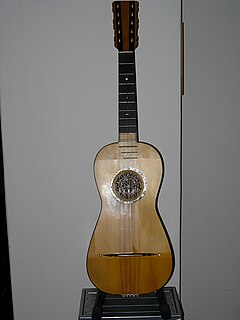
The chitarra battente is a musical instrument, a chordophone of the guitar family. It is similar to the 5-course baroque guitar, but larger and typically strung with five double strings, traditionally made of brass, but currently - steel. Nowadays it is typically used by folk musicians, mainly in the southern Italian regions of Calabria, Apulia, Basilicata, and Campania, as well as in other areas of southern Italy; in past centuries the instrument was found in most of central and southern Italy.

The Panche baja is a set of five traditional Nepali musical instruments that are played during holy ceremonies, especially marriages. Panche bajas are usually played by the Damai and the Gaine cates in the Hindu tradition.They are played using the rhythm of folk Nepali songs.It is named as Panchje Baja because in Nepali panch means 5 and the set includes five different types of instruments and baaja means musical instruments.

The Nepali Sarangi is a Nepali folk instrument. It is a chordophone played by bowing. Traditionally in Nepal, the Sarangi was only played by people of Gandarbha or Gaine caste, who sing narrative tales and folk song, however, in present days, its popularity extends beyond the Gandharba community and is widely used and played by other caste members as well. It has also garnered much interest in other music genres, such as Nepali rock and film music. While the Sarangi has become the quintessential Gandharba instrument, while its counterpart, the arbajo, which is a plucked lute, has fallen into obscurity.

The tube zither is a stringed musical instrument in which a tube functions both as an instrument's neck and its soundbox. As the neck, it holds strings taut and allows them to vibrate. As a soundbox or it modifies the sound and transfers it to the open air. The instruments are among the oldest of chordophones, being "a very early stage" in the development of chordophones, and predate some of the oldest chordophones, such as the Chinese Se, zithers built on a tube split in half. Most tube zithers are made of bamboo, played today in Madagascar, India, Southeast Asia and Taiwan. Tube zithers made from other materials have been found in Europe and the United States, made from materials such as cornstalks and cactus.
The Yalamber or Yahamber Baja is a Nepali tube zither in the Kirati tradition. It is one of three tube-zithers documented in Nepal by the Nepali Folk Musical Instruments Museum in 2004.
References
- 1 2 Lama Sherpa, Phudorji (4 October 2002). "In search of lost music". Nepali Times.
- 1 2 "Chordophones". Jwajalapa!. newatech, inc. 1 May 2008. Archived from the original on 22 May 2009. Retrieved 22 May 2008.
- ↑ Bana, Binit. "Afno Baja Chinau". Movers & Shakers.
- ↑ untothenight. "Baja-Teaser". youtube.com.
a traditional nepali folk instrument that is currently endangered.... "Piwancha" a Newari String Instrument.
